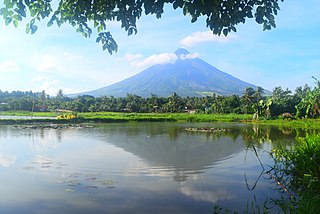
Albay, officially the Province of Albay, is a province in the Bicol Region of the Philippines, mostly on the southeastern part of the island of Luzon. Its capital is the city of Legazpi, the regional center of the whole Bicol Region, which is located in the southern foothill of Mayon Volcano.

Sorsogon, officially the Province of Sorsogon, is a province in the Philippines located in the Bicol Region. It is the southernmost province in Luzon and is subdivided into fourteen municipalities (towns) and one city. Its capital is Sorsogon City and borders the province of Albay to the north.

Bicol, known formally as the Bicol Region or colloquially as Bicolandia, is an administrative region of the Philippines, designated as Region V. Bicol comprises six provinces, four on the Bicol Peninsula mainland – Albay, Camarines Norte, Camarines Sur, and Sorsogon – and the offshore island provinces of Catanduanes and Masbate.

Camarines Sur is a province in the Philippines located in the Bicol Region in Luzon. Its capital is Pili and the province borders Camarines Norte and Quezon to the northwest, and Albay to the south. To the east lies the island province of Catanduanes across the Maqueda Channel.

There are some 120 to 187 languages spoken in the Philippines, depending on the method of classification. Almost all are Malayo-Polynesian languages native to the archipelago. A number of Spanish-influenced creole varieties generally called Chavacano are also spoken in certain communities. The 1987 constitution designates Filipino, a standardized version of Tagalog, as the national language and an official language along with English. Filipino is regulated by Komisyon sa Wikang Filipino and serves as a lingua franca used by Filipinos of various ethnolinguistic backgrounds.

The Bisayan languages or the Visayan languages are a subgroup of the Austronesian languages spoken in the Philippines. They are most closely related to Tagalog and the Bikol languages, all of which are part of the Central Philippine languages. Most Bisayan languages are spoken in the whole Visayas section of the country, but they are also spoken in the southern part of the Bicol Region, islands south of Luzon, such as those that make up Romblon, most of the areas of Mindanao and the province of Sulu located southwest of Mindanao. Some residents of Metro Manila also speak one of the Bisayan languages.
The Central Philippine languages are the most geographically widespread demonstrated group of languages in the Philippines, being spoken in southern Luzon, Visayas, Mindanao, and Sulu. They are also the most populous, including Tagalog, Bikol, and the major Visayan languages Cebuano, Hiligaynon, Waray, Kinaray-a, and Tausug, with some forty languages all together.

Masbateño or Minasbate/Masbatenyo is a member of Central Philippine languages and of the Bisayan subgroup of the Austronesian language family spoken by more than 724,000 people in the province of Masbate and some parts of Sorsogon in the Philippines. Masbatenyo is the name used by the speakers of the language and for themselves, although the term 'Minásbate' is sometimes also used to distinguish the language from the people. It has 350,000 speakers as of 2002 with 50, 000 who speak it as first language. About 250,000 speakers use it as their second language.

Naga, officially the City of Naga or the Pilgrim City of Naga, is a 1st class independent component city in the Bicol Region of the Philippines. According to the 2020 census, it has a population of 209,170 people.

Milaor, officially the Municipality of Milaor, is a 3rd class municipality in the province of Camarines Sur, Philippines. According to the 2020 census, it has a population of 33,963 people.

Pasacao, officially the Municipality of Pasacao, is a 3rd class municipality in the province of Camarines Sur, Philippines. According to the 2020 census, it has a population of 53,461 people.

The Bicolano people or the Bikolanos are the fourth-largest Filipino ethnolinguistic group. Males are usually referred to as Bicolano, and Bicolana is used for females. Their native region is commonly referred to as Bicolandia, which comprises the entirety of the Bicol Peninsula and neighboring minor islands, all in the southeast portion of Luzon.
Pandan Bikol, or Northern Catanduanes Bicolano, is one of the three groups of the Bikol languages. It is spoken in Pandan and northeastern portion of Catanduanes.

Rinconada Bikol or simply Rinconada, spoken in the province of Camarines Sur, Philippines, is one of several languages that compose the Inland Bikol group of the Bikol macrolanguage. It belongs to the Austronesian language family that also includes most Philippine languages, the Formosan languages of Taiwanese aborigines, Malay, the Polynesian languages and Malagasy.

The following outline is provided as an overview of and topical guide to the Philippines:

Coastal Bikol is one of the three groups or family languages of Bikol languages. It includes the extinct languages of Mt. Isarog Agta and Mt. Iraya Agta, and Central Bikol that includes Viracnon dialect.
The Negrito peoples of the Philippines speak various Philippine languages. They have more in common with neighboring languages than with each other, and are listed here merely as an aid to identification.

The Bikol languages or Bicolano languages are a group of Central Philippine languages spoken mostly in the Bicol Peninsula in the island of Luzon, the neighboring island province of Catanduanes and the island of Burias in Masbate.
Bisakol is an informal term for the three Bisayan languages spoken in the Bicol Region.
Northern Sorsogon is a Bisayan language spoken in the central part of Sorsogon, Philippines, in Sorsogon City and the municipalities of Casiguran, and Juban. It is closely related to, but distinct from Southern Sorsogon which is spoken in the southern part of Sorsogon.















